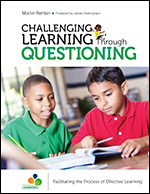Challenging Learning Through Questioning
Facilitating the Process of Effective Learning
Foreword by James Nottingham
Corwin Teaching Essentials
Better questioning for better learning
Questioning is a process that sparks discussion and encourages deeper thinking. Effective questioning builds on students’ natural curiosity, moving them out of their comfort zone and into the learning zone in a purposeful, accessible way. It also models the process of good thinking and fosters a culture of high expectations.
Like any skill, questioning takes practice. With this insightful guide, you’ll reframe your thinking and fine-tune the three essential questioning skills—know your intent, plan your responses, and stay purposefully silent—to elicit noticeably improved responses from students. Features include
· Questioning sequences that work in any discipline
· Techniques for deepening learning through questioning
· Organizational strategies for pair, small-group, and whole-class dialogues
· Best practices for balancing questioning, thinking tools, and strategic silences
· Exercises, activities, and review and reflection sections
High-quality questioning supports a culture in which students are not only challenged, but expect to be challenged, and where they flourish intellectually. Through your questioning, you’ll give them the tools they need to become thoughtful, confident, and independent learners.
"James Nottingham’s work on Challenging Learning is a critical element of creating Visible Learners. This new series will help teachers hone the necessary pedagogical skills of dialogue, feedback, questioning, and mindset. There’s no better resource to encourage all learners to know and maximize their impact!"
